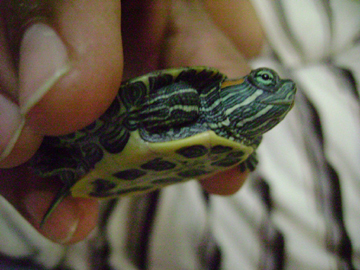Green Defenders
THE REPTILE RESCUE SQUAD
by
Aditi Baindur
The phone rang. “Dad”, I said, “It's Singhal Uncle and he wants to speak to you urgently.” Dad was conversing with my aunt's family who had come for dinner.
“Hi, what's up?... Uh huh... uh huh. don't worry, we'll come right away.”
Apologizing to my Bua, Dad told her that a friend had a snake in his drawing room that needed rescuing. Eagerly, I asked whether I could come along. After some thought Dad said, “Yes, you can be my assistant but you have to do exactly as I say!” Picking up
a snake-stick, butterfly net and the book on Indian Snakes, we got into the car and reached the Singhal's home – a low-slung bungalow opposite the Golf Course.
Singhal Uncle said that since he did not want to kill it, he had called us. We went inside and heard the snake hissing from behind the TV. The snake was quite infuriated at being disturbed. Carefully we moved the furniture to get a good look. The snake was
thick, stocky, and curled up. It had a triangular head held back in a S-shaped coil, ready to strike. It had large oval markings on its back – all distinctive characteristics of Russel's Viper (scientific name – Daboia russelii).
Russel's Viper is the largest Indian viper which is named after Patrick Russell (1726-1805), a Scottish surgeon and naturalist who came out to India and was the first person to study the snakes. Russel is called the “Father of Indian Ophiology” (ophiology=study
of snakes). Russel's Viper is dangerous – it is one of the Big Four venomous snakes of India, the others being the Cobra, Krait and Saw-scaled Viper. Russel's vipers are common in CME, this was to be the first of four that we were to encounter last season.
To the best of knowledge, in more than ten years, no venomous snake bite has been recorded in CME despite a large population of Big Four snakes.
Russel's Vipers are deadly and evil looking but are by nature docile and only bite if provoked or threatened. The Haffkinne anti-venin, available in MI Room, can be used to treat bites by any of the Big Fou r snakes. So while there is no need for any of us
to worry, all of us need to be alert and careful in grass, gardens or the countryside. Dad said, Russel’s Viper bite, is like having a live coal placed on the body. Sometimes, even if life were saved by treatment with anti-venin, a bite can leave a person
permanently crippled with amputated limbs or damaged internal organs. So Dad believes that we should never take silly risks handling snakes. Dad's credo is simple – we are here to rescue the snake and it has to be done without endangering either humans or
snakes.
The drawing room was crowded with furniture all of which could not be removed, and it seemed that Dad would need to handle the snake after all. However, he had other plans. He lifted the snake high with his snake-stick and plopped it into the butterfly net
where the snake hung immobilized. Dad then carried it across the road and released it into the jungle by cutting the butterfly netting above the snake. The snake fell down and immediately disappeared into the jungle. It was a perfect rescue – no human came
within three feet of the snake and it was harmlessly captured and released into the wild in less than five minutes. We thanked Singhal Uncle for not killing the snake and giving us a chance to rescue it.

|
Green Defenders
Greendefenders
Illegal trading of Assam roofed terrapin
By-Prajakta Hushangabadkar
Recently we found Assam roofed terrapin (kachuga sylhetensis) in an aquarium shop. They sell it openly, they call it Singapore turtle and charge 700-1000 rupee for each turtle. Amravati, Pune and Mumbai are places where shop keepers sell it openly.
On the other hand, forest department and wildlife conservation activists are trying hard to protect this species. Assam roofed terrapin is protected under Indian wildlife protection Act 1972 and comes in schedule 1.

Assam roofed terrapin is literally unknown in the hills of Nagaland , Meghalaya and Bangladesh which is where it comes from. These turtles are small in size 180mm shell length, shell is olive-brown above and yellow –orange stripe along back of head and brown
spot on head. They are found in shallow water of river and feed on fish.

In black market they have special value as some people want terrapin with more number of fingers or nails for use of fenshuie, some time they ask for terrapin with two number head /mouth. Because of some vague belief in their powers, even orthodox people
are now days indulging in illegal trading of Assam roofed terrapin.
We are requesting all wildlife lovers and conservators to try to stop illegal trading of this turtle by informing your nearest forest department.
(photos by Prajakta Hushangabadkar)
If you know people and organization doing work for wildlife rescue and rehabilitation , share their achievements and work in wildlife conservation at green-defenders on Indian wildlife club mail us at prajakta.greendefenders@gmail.com and copy to susan_sharma@hotmail.com
|